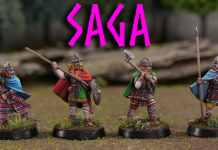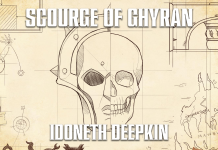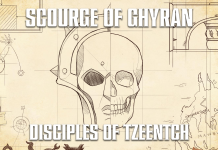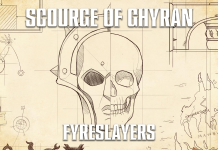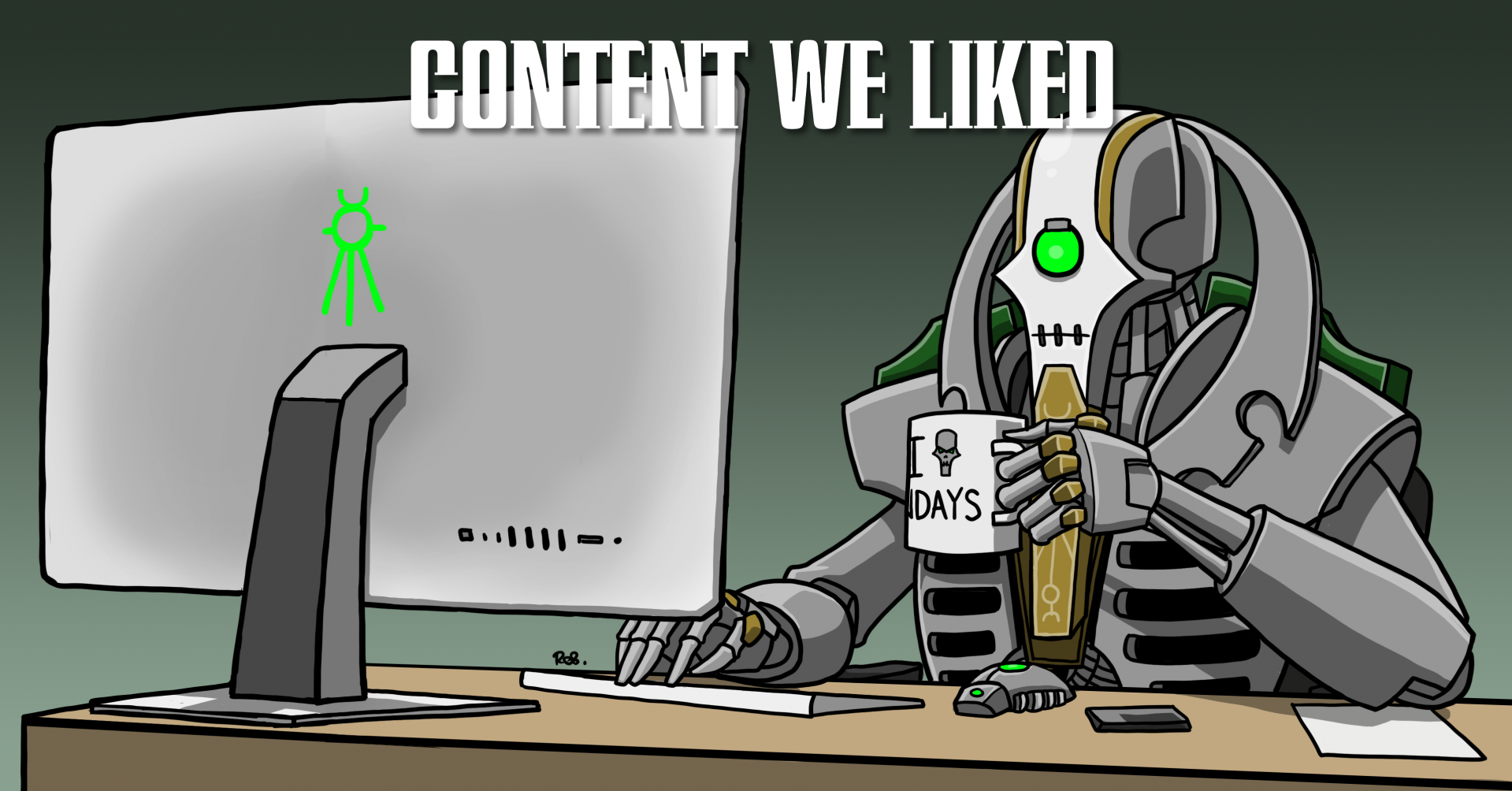One of the key challenges of Warhammer 40,000 is how to handle smaller games – that is, games played with fewer than 2,000 points. It’s clear – and it’s also been stated outright – that the game is balanced around competitive missions play at 2,000 points, and while that makes for the most balanced 40k has ever been for that format, it can leave a bit to be desired if you’re trying to play smaller games – which is pretty common if you’re new to the game or trying to play “slow grow” campaigns or Escalation Leagues.
The Problems with Small Battles
So what’s wrong with smaller games? What causes these games to feel lopsided, or tactically less interesting than larger games? We can hone in on a few things which are the main contributors:
- Lack of focus fire. Big, tough units really dominate at smaller points values. The reason is because the bigger your game gets, the more units you have in the early turns to attack and destroy a single unit. That big knight with T12 and 22 wounds maybe be super tough, but as soon as he sticks his head out in a 2,000 point game, you can train half a dozen tanks on him and just remove him from the table. In 1,000 point games you have half as many units to work with, and they don’t combine to the necessary output. So that knight survives, kills one or two of them, and then you’re unable to get the job done with your remaining units. While this problem is most prevalent with vehicles, it’s also easy to replicate with tough units like Terminators, Wraiths, or Thunderwolf Cavalry.
- Skew problems. As an add-on to that first thing, skew problems become even more of a challenge in smaller games, where it’s much harder to build all-comers lists and much less likely you’ll have the resources you need to handle a heavy skew.
- Board size. When going from Combat Patrol to Incursion you jump from a 44×30 board to a 44×60 board. For 500-point games, part of the adjustment is shifting deployment zones to be 20″ apart instead of 24″, letting you go up to 6″ in. That’s a big help but it does leave faster units advantaged as they now have much less ground to cover – and turn 1 charges are much more likely with units which can Advance and Charge. On the flip side, playing 1,000 point games on a 44×60 battlefield puts a ton of distance between units, and can make things feel empty.
- Missions and Scoring. Simply put, scoring is just harder at 1,000 points. You have fewer units to spread out with, and trying to cover three objectives in the middle of the table will likely leave you spread too thin. You also have fewer units to do actions with, making it harder to score on turns requiring three or more units to do actions.
Of these, the lack of focus fire and skew are the biggest issues – it’s just too easy to bring something that your opponent can’t do anything about in 1,000-point games, and the fix is either agreeing to not do that (with all the challenges involved), or letting everyone adapt, which can quickly turn the format into a bit of a battlecruiser-style play, with players opting for bigger tougher units which throw haymakers at each other. I think we can do better.
What Can We Learn from Boarding Actions?
I think the Boarding Actions supplement provides a great framework for how to solve this – by strictly limiting the units you can bring to the game for each faction it sidesteps the major challenges involved in balancing bigger or problem units, and it solves several other issues by just removing abilities that would be a problem in its cramped confines. A solution for 500- and 1,000-point games in the broader space will work very well here. This is largely better than Combat Patrol, which doesn’t give us any army building leeway, and so just doesn’t work in competitive 40k.
We can also resurface some older adjustments to the game made for 1,000 points – while Tenth Edition limits us to three of each Datasheet for non-Battleline units, that used to be capped at two in Ninth edition, and it’s worth bringing that back as well.
So putting all of this together, let’s talk about a revised framework for 500- and 1,000-point games.

Rules Guidelines for Playing Smaller Games
The biggest thing we need to do with these rules is restrict army construction to weed out most of the larger problem units while still leaving every army an avenue for play. To that end, we’d recommend the following adjustments for games of 1,000 points or below:
- Players may not take allied units using the Imperial Agents, Chaos Daemons, or Knights rules. Keep your army to a single Codex or Index. This helps cut down on a few other issues, and keeps knights armies from being a bit too versatile.
- Players may not take units with the AIRCRAFT or TITANIC keywords. These battles are too small for the likes of these, and while I don’t think there are any Titanic Units with 12 or fewer wounds, I’m comfortable just throwing this one out there.
- Datasheet Restrictions. Similar to standard Strike Force games, smaller games use limits on the number of units which can be drawn from a single datasheet in a player’s army. In this case the recommended limits are one non-Battleline /three Battleline for 500-point games, and two non-Battleline/four Battleline for 1,000-point games.
- Cull the Horde: Change this to score when destroying a unit with a starting strength of 12+ models or 20+ wounds. Otherwise you have to remove it from the deck but it makes more sense to realign the secondary mission for the format.
- Imperial Knights: At the start of the game, an Imperial Knights player nominates a single Knight to gain the CHARACTER keyword – this model is considered their warlord.
500 Point Games (Patrol)
Points Limit: 500
Board Size: 44″x30″
Maximum Units per Datasheet: 1 / 3 Battleline
At this point I’m a big fan of just using the Boarding Actions rules, even if you’re playing on more open terrain. At the very least, you’ll want to use Boarding Actions Detachments for army building, as those do a solid job restraining armies to their specific units which are better-suited for smaller tables and close quarters. The size of a Boarding Actions table is 55.4×47.8, and that’s notably larger than the 44×30 you get running Combat Patrol, but without the twisting maze of Gallowdark Terrain it’s going to feel larger and more open. For this mode your biggest challenge is going to be that Pariah Nexus Missions aren’t set up for play on that board size. So I’d recommend instead using the Combat Patrol missions from the Tenth Edition Core rules, and potentially adding in Pariah Nexus Secondary Missions.
Additionally we’d recommend the following:
- Players cannot take models with a Wounds Characteristic of 13 or higher. This ensures Knights players can still play the game at these levels, but cuts down substantially on the tougher, more durable units which can cause problems in smaller games.
- Players can only take minimum-size units. Although not big vehicles, 20-model Necron Warrior units and big terminator bricks can be a real problem at 500 points, and so it makes sense to limit your unit sizes at this points level. This helps cut down on oppressive infantry units which could also skew the game, such as Thunderwolf Cavalry or Terminators.
1,000 Point Games (Incursion)
Points Limit: 1,000
Board Size: 44″x60″
Maximum Units per Datasheet: 2 / 4 Battleline
For 1,000-point games you can just use the standard Pariah Nexus missions and scoring, using the updated army building guidelines. Yeah, you can still work on some skew options, but the idea of six Redemptors is a lot less scary. That said, it’s worth suggesting that if you’re having some issues with player lists, you can look at enforcing some additional restrictions that treat things like Predator and Storm Speeder variants as the same datasheet.
Note that these restrictions should only be applied when a game has 1,000 points per player side in a game, and shouldn’t necessarily be applied to a 2v2 game where each player has 1,000 points – those are essentially just 2,000-point games.
- Players cannot take models with a Wounds Characteristic of 14 or higher. Initial testing around a wound cap of 12+ really seemed to gut guard armies, who suddenly lost the ability to take Leman Russ tanks, while helping Chaos Space Marines, who could still take Forgefiends and Maulerfiends. Going up to 13 wounds allows a few more key vehicles without making things too difficult.
- Players cannot take units with a points cost of 201 points or more unless they are minimum-size units. Rather than limiting players to minimum size units, it makes more sense to limit the points cost of any individual unit. This gives you the opportunity to take things like seven-man plague marine units or twenty Necron Warriors, but not bigger bricks of things like Terminators which might cause similar problems. We’ve added the “unless they are minimum size” here to account for things like Grey Knight Paladin Terminators, who come out to 215 points at minimum size.
Scaling Up
We’ve purposely gone with a conservative approach to banning large units here – 13 wounds is an important breakpoint because it excludes heavier tanks but leaves players able to take things like Leman Russ Tanks, while the 200 points limit prevents things like three-Nemesis Grey Knights builds which would be a nightmare to play against. But if your play group needs to adjust these, feel free to give it a shot and let us know how it works out! This system isn’t perfect and there are some advantages and disadvantages to changing things up – the key is to build something that works for your play group. We’ve tried to make something here that’s pretty universal, but if you have T’au players who need to run a Riptide and you aren’t worried about triple Dreadknights or a pair of Rogal Dorns at 1,000 points, feel free to tweak some of those numbers.
Otherwise, that’s it – Let us know how things work out for you in your games, and if you have any recommendations or suggestions, shoot those our way. Our general plan is to run these for Crusade campaigns and events, and they should hopefully work well for your own campaigns and escalation leagues.
Have any questions or feedback? Drop us a note in the comments below or email us at contact@goonhammer.com. Want articles like this linked in your inbox every Monday morning? Sign up for our newsletter. And don’t forget that you can support us on Patreon for backer rewards like early video content, Administratum access, an ad-free experience on our website and more.

